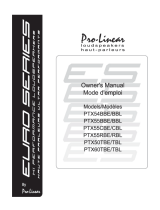
STEP 1
L
oudspeaker Placement
Placement of your loudspeakers will greatly affect their performance.
The following guidelines should be considered:
Placing the loudspeakers at least 6-8
feet (1.8-2.5m) apart will provide the
best stereo sound and image.
The shape of the room will affect the
bass performance, especially when
loudspeakers are placed in the corner
of the room.
Positioning the tweeters so that they
play at the listeners ear level provides
for optimum playback.
Keeping the loudspeaker wire away
from AC outlets will reduce interference.
The shape of the listening room and the furnishings will change the way your
system sounds.The bass frequencies will generally be affected by the position-
ing and treatment of the room.There will be more perceived bass when a
speaker is moved closer to a wall boundry. In general, however, loudspeakers
should be kept away from side walls as much as possible, as these surfaces can
adversely affect the stereo imaging experienced at the listening position.
Positioning the loudspeakers at least 12-15”away from the side walls and 12-
18”from the rear wall will generally provide the best performance.
Home-Theatre
Today’s home theatre systems typically comprise front loudspeakers, side
and/or rear loudspeakers, a centre channel loudspeaker and a powered sub-
woofer. Building your system with loudspeakers of the same brand produces
the best performance as the tonal characteristics will remain the same through-
out your surround system.
Front Channels
Placement of your front loudspeakers is critical to the performance of your sys-
tem.The 3 front loudspeakers should ideally be placed with the tweeters at the
same height and the same distance form the main listening position. If this not
possible, place the centre channel on top of, or just below, the television, with
the front left and front right loudspeakers on either side of the TV monitor.
Rear Channels
Rear channel loudspeakers can be either floor standing or smaller bookshelf
type loudspeakers. Bookshelf loudspeakers should be placed on stands or on a
shelf to maximize their performance. Aiming the loudspeakers to the listening
position or aiming them away from the listening position will provide different
sound fields (direct or diffused), based on your preference.
Powered Sub
A powered subwoofer will reinforce the
lower frequencies in any system and will
also greatly enhance your stereo and
home-theatre listening experience.Today’s
media, such as CD’s, DVD’s and other high
quality music and movie software feature
low frequency sounds that are difficult for
most loudspeakers to reproduce.Adding a
powered subwoofer will greatly improve
the overall systems frequency response
because it is designed to play the frequen-
cies that your main loudspeakers cannot
play efficiently.Your authorized Cerwin-
Vega dealer can assist you in choosing the
subwoofer that is right for you.
LF
LS RS
RF
S
Approximately
equal distances
ÉTAPE 1
Placement des haut-parleurs
Le placement de vos enceintes affectera leur son.
Les indications suivantes devraient être considérés:
Séparer les enceintes d’au moins 1.8-2.5
mètres, ceçi vous donnera une bonne
définition stéréo.
La forme de la pièce affectera les basses
fréquences, partic ulièrement quand les
enceintes sont près d’un coin.
Les haut-parleurs d’aigus devraient être
aux niveau des oreilles pour une
reproduction optimale.
Le câblage devrait être posé le plus loin
possible des prises électriques afin
d’éviter les interferences.
La forme de la salle d’écoute et l’ameublement changeront la réponse de
fréquence de votre système. Les basses fréquences sont affectez par la position
des haut-parleurs dans la salle. Plus l’enceinte est proche d’un mur, plus les bass-
es fréquences seront mise en évidence. Malgré ça, l’enceinte devrait être le plus
loin possible des surfaces à réflexions, car ceux-ci peuvent compromettre l’effet
stéréo à la position d'écoute. Positionnant les enceintes à environ 30-40cm des
murs à côté arrière vous donnera généralement la meilleure performance.
Cinéma-Maison
Les Systèmes de cinéma-maison comprennent typiquement des enceintes
avants, de côté et/ou arrière, une enceinte centrale et un sous-grave amplifié. En
formant votre système avec des enceintes d’un seul fabricant, vous donnera la
meilleure performance car les caractéristiques sonores des enceintes seront
indiques.
Canaux Avant
La posiion des enceintes avants et très importante pour la performance de vôtre
système. Idéalement les enceintes avants devraient avoir les haut-parleurs aigus
à la même hauteur, et au niveau de la position d’écoute. Si cela n’´st pas possi-
ble, mettez l’enceinte centrale en dessous ou sur le téléviseur, avec les enceintes
avants de chaque côté du téléviseurs.
Canaux Ambiophoniques
Les enceintes d’ambiophonie peuvent être de type de plancher où de type d’é-
tagèr
e
. L
es enceintes de type étagère devraient être placés sur des supports, ou
une tablette à la hauteur appropriée. Les enceintes peuvent être dirigés vers la
position d
’
écout
e pour un son plus dir
ec
t
e ou si un son plus en
v
eloppant est
préféré, les enceintes peuvent être dirigés vers l’avant de la salle.
S
ous-gr
a
v
e
Un sous-
grave amplifié augmentera con-
sidérablemen les basse fréquences de
vôtre système stéréo ou cinéma-maison.
Les pistes numeriques de hautequalité en
format CD, ou DVD sont plus difficiles à
reproduire que jamais. En ajoutant un sous-
g
ra
v
e amplifié
, la per
formance de vôtre
système sera accentué dans le régistre
grave. Vôtre detaillant autorisé pourra vous
aider à sélec
tionner un sous-grave Cerwin-
Vega qui sera bien s’intégré à vôtre sys-
t
ème audio/vidéo
Distances
approximativement égales
GA
GA
DA
DA
S
E
nglish Français








